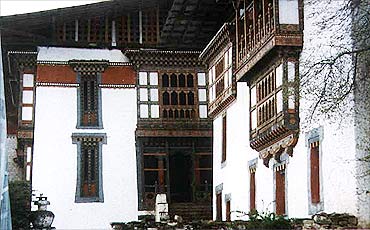|
 availability
of building materials; availability
of building materials;
 physical
and climatic conditions; physical
and climatic conditions;
 social
and economic development; social
and economic development;
 religious
and cultural traditions. religious
and cultural traditions.
The
main materials used have been stones, compressed earth (mud), wood and
bamboo. Stone or rock is mostly used for dzongs and religious buildings
while village houses are made of stones and compressed earth. Wooden shingles
are commonly used for roofing. In some parts of eastern Bhutan bamboo mats
are also used for roofing. Wood is used especially for windows, balconies
of dzong buildings and temples. Windows have a distinctive trefoil shape
and elaborate lintels painted with geometrical and floral motifs.
The characteristics
of Bhutanese architecture are generally:
 lavish
use of wood; lavish
use of wood;
 sloped
whitewashed walls; sloped
whitewashed walls;
 window
size increasing with the stories; window
size increasing with the stories;
 he
trefoil shaped windows; he
trefoil shaped windows;
 he
pitched roof covered with shingles and weighed down with stones. he
pitched roof covered with shingles and weighed down with stones.
Once
the building is completed, artists often embellish it by painting different
auspicious motifs. The selection of the site for any building, as well
as the different steps of the construction, are guided by the astrologer's
calculations and always followed by rituals. For religious buildings, the
configuration of the site and good omens are considered very important.
Within
seven months, several important structures were completed. Among them was
the Taktshang Pelphug which houses three lhakhangs: the Phurpai
Dubkhang on the ground floor where Guru Rinpoche meditated;
the Guru Sungjoen Lhakhang, situated on the first floor of the building
and named after the image of the Guru which is believed to have
spoken; and the Guru Tshen Gyed Lhakhang, on the top floor, named
after the eight manifestations of Guru Rinpoche.
A
fire proof structure (methub) will be constructed in the Chorten
Lhakhang to safeguard the sacred nangtens from fire and theft.
| Information on Bhutan |
 |
|



![]() availability
of building materials;
availability
of building materials;
![]() physical
and climatic conditions;
physical
and climatic conditions;
![]() social
and economic development;
social
and economic development;
![]() religious
and cultural traditions.
religious
and cultural traditions.

![]() lavish
use of wood;
lavish
use of wood;
![]() sloped
whitewashed walls;
sloped
whitewashed walls;
![]() window
size increasing with the stories;
window
size increasing with the stories;
![]() he
trefoil shaped windows;
he
trefoil shaped windows;
![]() he
pitched roof covered with shingles and weighed down with stones.
he
pitched roof covered with shingles and weighed down with stones.

